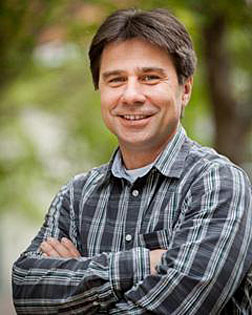- Number 382 |
- February 18, 2013
SLAC's Yakimenko guides future of FACET

Vitaly Yakimenko
Growing up in the former Soviet Union, Vitaly Yakimenko says, kids who did very well in school had a choice of two career paths: politics or science. “Science was always more interesting,” says Yakimenko, who recently joined DOE’s SLAC National Accelerator Laboratory as director of FACET, the Facility for Advanced Accelerator Experimental Tests.
He is quick to share another reason for staying on the path of science, one that has deepened over the course of his career: “I enjoy the company of my colleagues. To be surrounded by very smart people most of your life is a rare gift.”
That’s one of the many appeals of SLAC, Yakimenko says, along with strong leadership and the prospect of continuing to work with people who are very knowledgeable, and from whom he expects to learn much.
“I plan to jump in as soon as possible into the work,” he said. “I want to learn how I can contribute to make FACET even more successful and give it a future beyond 2016,” when LCLS-II will require the second third of SLAC’s linear accelerator.
He’s especially interested in the future of FACET. As he puts it, “everything is unknown. It’s very exciting to come to work and not know what to expect. There are many surprises, quite often challenging.”
FACET is a research and development facility for experimental beam physics. It opened to users in May.
“With Vitaly Yakimenko we have been able to attract somebody who understands the science, knows how to operate a user facility and has a vision for the future,” said Norbert Holtkamp, director of SLAC's accelerator directorate. “What else could I have hoped for? I look forward to working with Vitaly and his colleagues to pave a path that will attract more users and new programs to this unique facility.
Yakimenko comes to SLAC from Brookhaven National Laboratory, where as director of the Accelerator Test Facility he undertook major upgrades to its advanced accelerator scientific programs. Under his leadership, both the experimental program and ATF’s user community grew significantly: The number of students, active experiments and journal publications more than doubled over the past three years.
His research focused on the physics of beams, intense radiation sources, free-electron lasers and the interaction of charged particles, laser beams and plasmas. His usual workload was “around 15 projects,” he says, and he expects to continue at that pace here at SLAC. He enjoys taking on multiple projects, basking in the energy of new ideas and contributing to advances in science.
Some of those advances were recognized earlier this year when IEEE awarded him its 2012 Particle Accelerator Science and Technology Award. The award acknowledges Yakimenko’s “contributions to high-brightness electron beams and their application to advanced accelerators and light sources,” noting the potential for advances in a wide range of fields, such as renewable energy sources and biology.
Yakimenko began his career at the Budker Institute for Nuclear Physics, in the Russian city of Novosibirsk, after earning his Ph.D. in accelerator physics. He worked briefly at DESY in Hamburg, Germany, and GSI Helmholtz Center for Heavy Ion Research in Darmstadt – and then went to Brookhaven. Once there, he worked his way up from postdoctoral researcher to Accelerator Test Facility director in 2004.
In his free time, he likes to have fun with his family – his wife, their 22-year-old son and 9-year-old daughter – and a small assortment of pets, including a Siamese cat, a gecko and a variety of tropical fish. He adds that he would like to play tennis, but with time constraints – at least at first – “I suspect not.”Submitted by DOE's SLAC National Accelerator Facility
